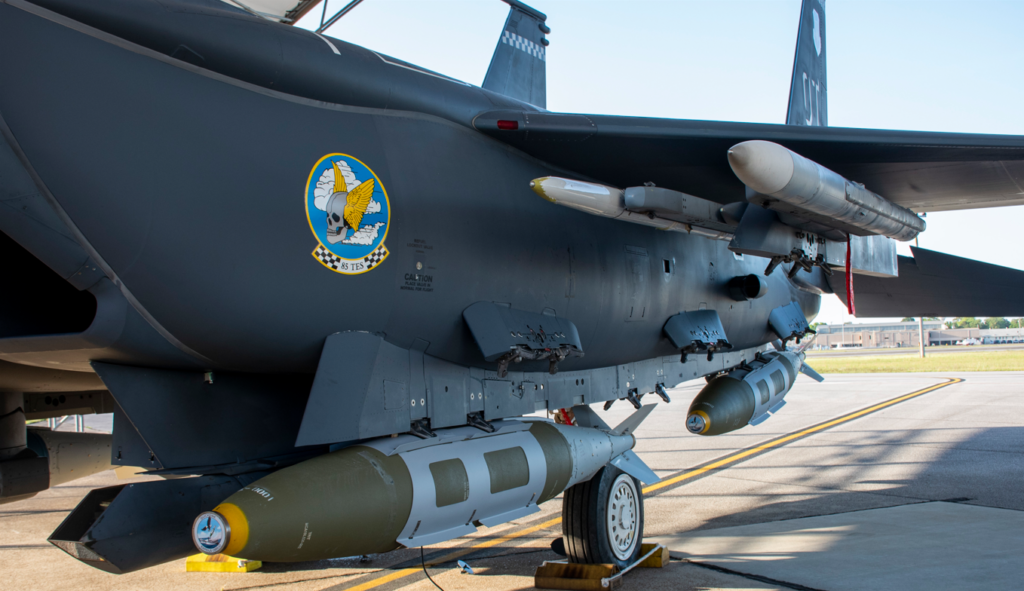
The U.S. Air Force recently showcased its growing naval superiority by successfully testing a new ship-killing guided bomb. A B-2 stealth bomber dropped the weapon, dubbed QUICKSINK by the Air Force Research Laboratory, on an empty cargo vessel in the Gulf of Mexico. This technology is designed to ensure the U.S. military can effectively defend its interests, maintain open sea lanes, and dominate vast maritime regions. The Air Force is developing QUICKSINK to enhance its anti-ship capabilities, which would be crucial in a potential conflict with China or other major adversaries. The QUICKSINK program aims to modify existing or future weapons to target both stationary and moving maritime vessels.
QUICKSINK is a Joint Capability Technology Demonstration (JCTD) that rapidly integrates and demonstrates Department of the Air Force technology to provide air-delivered, low-cost, surface vessel defeat capabilities. This JCTD utilizes an existing guidance kit combined with a new seeker to quickly demonstrate the capability at minimal cost. The WOSA seeker also allows the technology to be integrated into various current and future weapon systems, enabling them to engage both static and moving maritime targets.
QUICKSINK is not a mine and is designed to have an immediate impact on stationary or moving maritime targets. While torpedoes, such as the heavyweight MK-48, remain the primary method for sinking enemy ships, QUICKSINK explores new approaches to achieve similar anti-ship lethality using air-launched weapons, including modified 2,000-pound class precision-guided bombs.
A Navy submarine can launch and destroy a ship with a single torpedo, but doing so reveals its location and makes it a target. The QUICKSINK JCTD aims to develop a low-cost method for achieving torpedo-like seaworthy kills from the air at a much faster pace and over a much larger area than a submarine can cover.
QUICKSINK’s use of WOSA reduces the cost of the most expensive part of the weapon system and offers modularity, allowing for the integration of different manufacturers’ seeker components to further lower costs or improve performance. With a range of up to 28 kilometers, JDAMs can be launched far from the target. Beyond their potential to sink ships, their affordability allows for overwhelming a ship’s defenses with a barrage of these bombs, ensuring at least one gets through.
For maximum effectiveness, JDAMs ideally follow a near-vertical trajectory in the final descent. This makes them very difficult to deflect, especially compared to laser-guided bombs (LGBs). LGBs initially travel in a ballistic arc, then adjust their course using a laser designator, often requiring minimal corrections from their ballistic path.
In contrast, JDAMs pre-program their target location and begin course corrections immediately after release. They can also be programmed to attack from specific angles or directions. This might involve flying sideways briefly, then turning to approach at a 270-degree heading, or even flying almost directly over the target before making a sharp turn to strike at an 85-degree angle. This makes their flight path significantly less predictable for enemy forces compared to LGBs.
These munitions would likely avoid proximity fuses, opting for delayed crush fuses instead. When a missile explodes near a JDAM equipped with a crush fuse, the fuse is crushed, triggering a timer that detonates the bomb a few moments later, ideally over 500 yards from the target. This approach might cause some damage but wouldn’t result in a rapid sinking.
AGM-158C LRASM (Long Range Anti-Ship Missile) is a large and expensive missile. There’s a reason for its size and cost. I’m optimistic that they can make it smaller and cheaper, though it will require significant advancements. Even if they can reduce the size of the guidance kit, there are limitations to scaling down electronics without compromising performance. Shrinking electronics beyond a certain point will increase costs or reduce capabilities. Many electronic components are essential for mission success and cannot be easily scaled down. Even with a 10% reduction in warhead size (which is unrealistic), the resulting warhead would be too small to effectively target larger vessels like frigates.
The primary threat isn’t frigates or corvettes, but larger ships like the Type 052D and Type 055. Even if the stealthy aspects of LRASM were cheaper, and all other advancements were achieved, this missile wouldn’t be suitable for countering China’s most significant naval threats.
To effectively target these threats, U.S Air Force would need to launch so many missiles that the overall cost would be comparable to LRASM. Additionally, using these missiles would put more aircraft at risk. QUICKSINK is not necessarily a suitable counter-China capability. It might be better suited for missions against Iran or Russia. However, even in these scenarios, it may not be approved by procurement oversight agencies due to its limitations. Existing missile systems can already target smaller threats at a similar cost. If the goals are more limited, such as sensor killing or increasing salvo survivability, QUICKSINK might be more viable.
